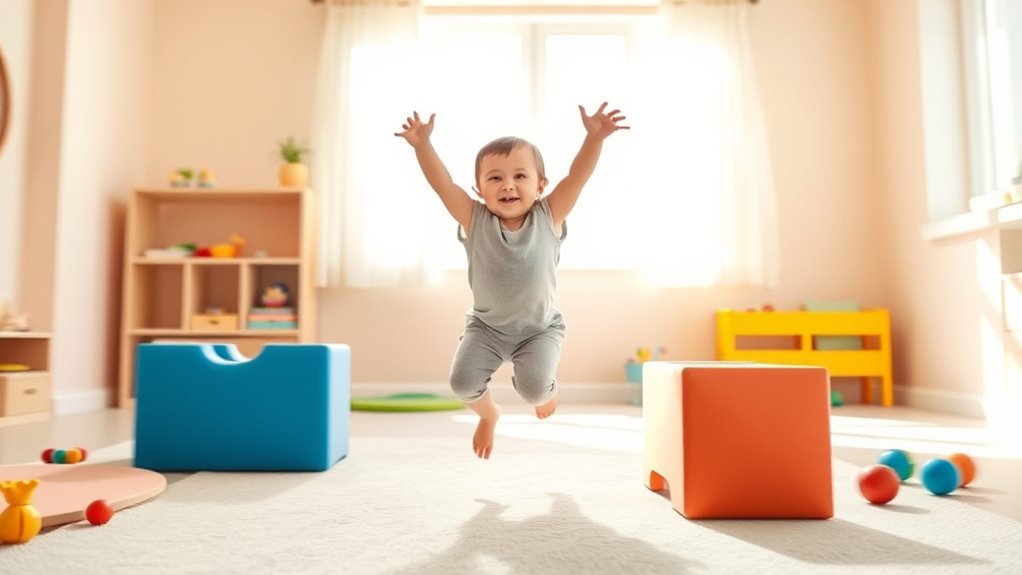In just five minutes, you can boost gross motor skills by incorporating micro-movements like balance exercises, crawling games, and simple obstacle courses. Activities such as standing on one foot, crawling through tunnels, or maneuvering balance beams challenge your child’s stability and coordination, strengthening small muscles essential for larger movements. These quick, fun routines help improve core strength, spatial awareness, and confidence. Keep exploring more simple strategies to support ongoing motor development effectively.
Key Takeaways
- Incorporate quick balance exercises like one-legged stands or imaginary tightrope walking to strengthen stabilizer muscles.
- Use crawling activities such as obstacle courses or racing to enhance coordination and limb control in short sessions.
- Integrate playful micro-movements like jumping jacks or hopping to build core strength and improve overall gross motor skills.
- Engage children in brief, lively routines combining balance, crawling, and jumping to maximize skill development in under 5 minutes.
- Consistently include micro-movements in daily play to foster confidence, stability, and foundational motor control efficiently.

Micro-movements, small but intentional movements, can markedly enhance a child’s gross motor skills. These tiny actions may seem insignificant, but when integrated into play, they build strength, coordination, and confidence. One effective way to incorporate micro-movements is through simple balance exercises. By encouraging your child to stand on one foot, walk along a line, or balance on a sturdy object, you challenge their stability and proprioception. These activities don’t require much time but deliver noticeable improvements in core strength and equilibrium. You can make them fun by turning balancing into a game—like pretending to be a flamingo or walking like a tightrope walker. Such playful balance exercises stimulate the small muscles responsible for maintaining stability, which are essential for overall motor development.
Crawling activities are another powerful method to promote gross motor skills through micro-movements. Crawling not only strengthens the arms, legs, and core but also refines coordination as your child learns to coordinate limbs and balance their weight. You don’t need elaborate setups—simply creating a safe, soft space for crawling can make a big difference. You might set up a mini obstacle course with cushions or tunnels, encouraging your child to crawl over, around, and through objects. These activities foster small, precise movements that strengthen muscles and enhance spatial awareness. As your child navigates these obstacles, they develop better control over their limbs and improve their overall motor planning.
Incorporating quick, targeted balance exercises and crawling activities into daily routines can be surprisingly effective. Just a few minutes of dedicated play can lead to noticeable progress. For example, challenge your child to hold a plank for a few seconds or to balance on one leg while reaching for a toy. Combine this with crawling games, like racing from one point to another or crawling through a maze of cushions. Keep the activities lively and engaging, so your child stays motivated. Over time, these micro-movements help develop the foundational strength and coordination necessary for more complex motor skills, like jumping, running, and climbing.
Frequently Asked Questions
Can Micro-Movements Improve Gross Motor Skills in Children With Developmental Delays?
You might wonder if micro-movements can help children with developmental delays improve gross motor skills. The answer is yes; these small actions support sensory integration and motor planning, essential for developing larger movements. By incorporating brief, targeted micro-movements into daily routines, you can enhance your child’s coordination and strength, making a noticeable difference in their gross motor development over time.
Are There Age-Specific Micro-Movements Recommended for Different Early Childhood Stages?
Imagine a toddler learning to walk; age-specific exercises like gentle balance games support developmental milestones. For early childhood, micro-movements tailored to each stage enhance gross motor skills effectively. You should focus on age-specific exercises that align with developmental milestones, such as crawling, standing, or jumping. These targeted movements optimize progress, ensuring children develop skills suited to their age and developmental stage, making early motor development more engaging and successful.
How Often Should Micro-Movements Be Incorporated Into Daily Routines for Best Results?
To see the best results, incorporate micro-movements into daily routines several times a day, aiming for at least 3-4 short sessions. Use integration strategies like pairing movements with regular activities, such as playtime or shifts, to make them natural and consistent. Follow frequency recommendations to guarantee steady development without overwhelming your child, helping them build gross motor skills effectively and enjoyably.
Do Micro-Movements Have Benefits for Children With Physical Disabilities?
Think of micro-movements as tiny sparks that can ignite big changes. For children with physical disabilities, these movements serve as gentle bridges to sensory integration and muscular strengthening. You can see their confidence grow as they navigate small, manageable tasks. These micro-movements help release potential, making daily routines more accessible and empowering children to develop essential gross motor skills at their own pace.
Are There Any Safety Concerns or Contraindications for Certain Micro-Movements?
You should always consider safety when introducing micro-movements. Conduct a thorough risk assessment to identify any potential hazards, especially for children with physical disabilities. Follow supervision guidelines carefully, ensuring an adult is present to monitor the child’s response and prevent overexertion or injury. While micro-movements are generally safe, certain movements might not be suitable for all children, so personalize activities based on individual needs and limitations.
Conclusion
In just a few minutes of simple micro-movements, you can considerably boost your child’s gross motor skills. It’s tempting to think big efforts are always necessary, but sometimes, small, consistent actions make the biggest difference. Trust the idea that tiny, intentional movements can create lasting development. By incorporating these quick activities into daily routines, you’re not just helping their muscles grow — you’re nurturing confidence and a love for movement that lasts a lifetime.










